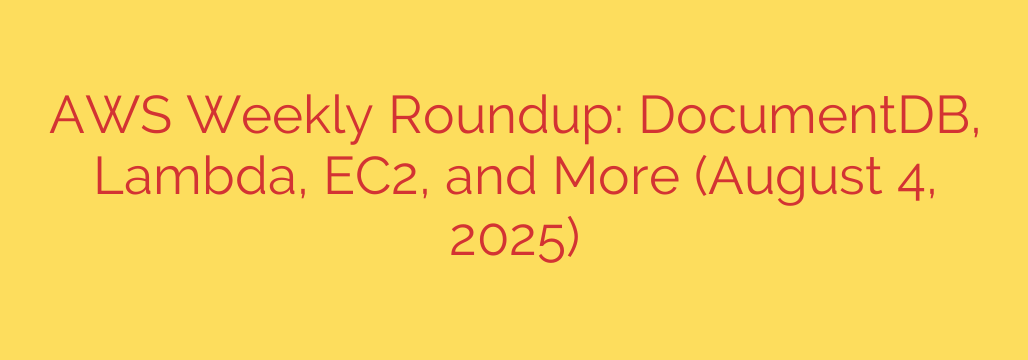
Major AWS Updates Unveiled: Game-Changing Features for DocumentDB, Lambda, and EC2
Keeping up with the pace of innovation at Amazon Web Services can feel like a full-time job. The platform is constantly evolving, with new features and services designed to enhance performance, improve security, and drive down costs. Recently, a wave of significant updates has been rolled out across several core services, offering powerful new capabilities for developers, data scientists, and infrastructure engineers.
Let’s dive into the most impactful changes for Amazon DocumentDB, AWS Lambda, and EC2, and explore what these advancements mean for your cloud architecture.
Supercharging Your Databases: Amazon DocumentDB Gets a Major Performance Boost
For teams leveraging MongoDB-compatible workloads, Amazon DocumentDB is a critical component. A common challenge, however, has been managing I/O-intensive applications without over-provisioning resources. To address this, AWS has introduced a significant architectural upgrade.
The headline feature is the launch of new I/O-Optimized storage clusters for Amazon DocumentDB. This new configuration is engineered to deliver enhanced performance and more predictable pricing for applications with high read and write throughput.
Key benefits of this update include:
- Improved Latency and Throughput: By optimizing the data path between the compute and storage layers, these new clusters can handle demanding workloads with significantly lower latency.
- Predictable Costs: The I/O-Optimized model bundles storage and I/O operations into a single, straightforward price. This eliminates the variable I/O charges that could lead to unexpected spikes in your monthly bill, making it ideal for budgeting.
- No Application Changes Required: Migrating an existing DocumentDB cluster to the I/O-Optimized model is a straightforward process that requires no code changes in your application.
Actionable Tip: If your application is sensitive to database read/write latency or you’ve struggled with unpredictable I/O costs, it’s time to evaluate a migration to the new I/O-Optimized storage for DocumentDB.
Rethinking Serverless: AWS Lambda Tackles Cold Starts and Memory Management
AWS Lambda continues to be the cornerstone of serverless computing, but two persistent challenges have been cold starts and efficient memory allocation. The latest updates tackle both issues head-on.
First, the highly anticipated Lambda SnapStart is now available for Python and Node.js runtimes. Originally launched for Java, SnapStart dramatically reduces startup latency for functions that are invoked infrequently. It works by creating an encrypted snapshot of the initialized function’s memory and disk state, caching it for reuse. When the function is invoked, it resumes from the snapshot, bypassing the time-consuming initialization phase. For applications requiring near-instantaneous response times, this is a game-changer.
Second, AWS is introducing a feature called Dynamic Memory Allocation for Lambda. Previously, you had to allocate a fixed amount of memory for your function, which often led to over-provisioning and wasted spend. With this new capability, Lambda can adjust memory allocation on the fly based on the function’s real-time needs, ensuring you only pay for what you actually use while still meeting performance requirements.
Next-Generation Compute: Introducing New Graviton-Powered EC2 Instances
The push for better price-performance in cloud computing is relentless, and AWS continues to lead the charge with its custom-designed Graviton processors. The latest announcement unveils the new Hpc7g instance family, powered by the latest generation of AWS Graviton processors.
These instances are specifically engineered for high-performance computing (HPC) and tightly-coupled workloads. Key features include:
- Enhanced Processor Performance: The new Graviton processors deliver a substantial leap in computational power and memory bandwidth compared to previous generations.
- High-Speed Networking: Hpc7g instances are equipped with the Elastic Fabric Adapter (EFA), providing up to 200 Gbps of low-latency, high-bandwidth networking, which is crucial for distributed computing tasks.
- Optimized for Scale: These instances are ideal for workloads like genomic sequencing, computational fluid dynamics (CFD), and large-scale AI model training that require massive parallel processing across thousands of cores.
Security Tip: When deploying new EC2 instances, always ensure they are launched within a private subnet and that your Security Group rules adhere to the principle of least privilege, only allowing traffic from trusted sources on necessary ports.
Key Security and Networking Enhancements You Can’t Ignore
Beyond the major service updates, several smaller yet critical enhancements have been released to bolster security and networking.
Notably, IAM Access Advisor now uses machine learning to provide more proactive and accurate recommendations. It analyzes your CloudTrail logs to identify unused permissions with greater precision, helping you refine your IAM policies and enforce least-privilege access more effectively.
Additionally, AWS CloudFront has rolled out Real-Time Edge Analytics. This allows you to monitor key performance and security metrics from CloudFront’s edge locations with sub-minute latency, enabling you to detect and respond to traffic anomalies or potential DDoS attacks much faster.
These updates represent a significant step forward, providing tangible improvements in performance, cost-efficiency, and security. We recommend reviewing your current architecture to see where these new features can be leveraged to build more robust, scalable, and cost-effective applications on AWS.
Source: https://aws.amazon.com/blogs/aws/aws-weekly-roundup-amazon-documentdb-aws-lambda-amazon-ec2-and-more-august-4-2025/








